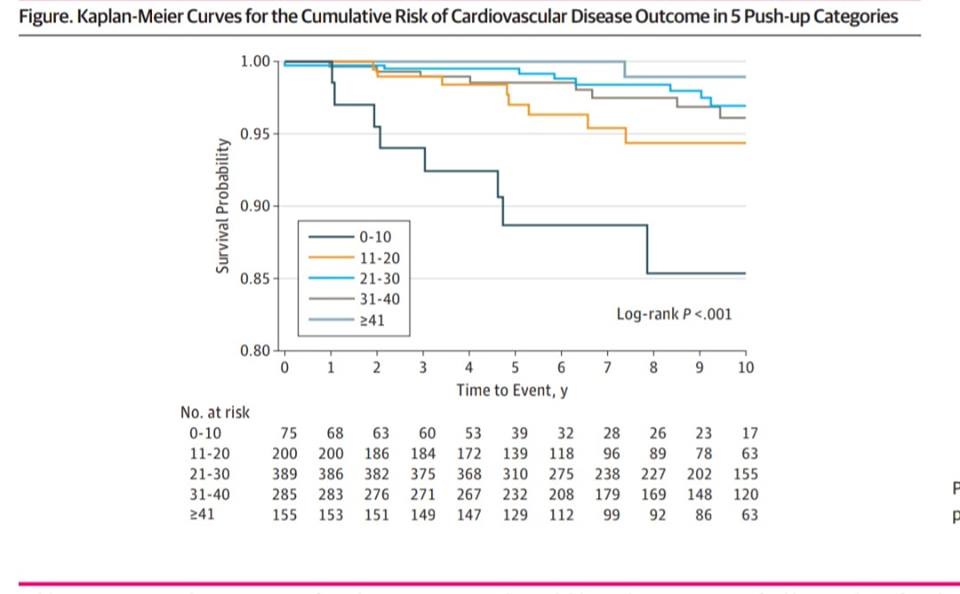15 Φεβρουαρίου 2019, Association Between Push-up Exercise Capacity and Future Cardiovascular Events Among Active Adult Men - JAMA Network Open.
 Question Is there an office-based objective measurement that clinicians can use to assess the association between fitness and cardiovascular disease risk?
Question Is there an office-based objective measurement that clinicians can use to assess the association between fitness and cardiovascular disease risk?
Findings This longitudinal cohort study of 1104 occupationally active adult men found a significant negative association between baseline push-up capacity and incident cardiovascular disease risk across 10 years of follow-up. Participants able to complete more than 40 push-ups were associated with a significant reduction in incident cardiovascular disease event risk compared with those completing fewer than 10 push-ups.
Meaning Push-up capacity is a no-cost, fast, and simple measure that may be a useful and objective clinical assessment tool for evaluating functional capacity and cardiovascular disease risk.
Importance Cardiovascular disease (CVD) remains the leading cause of mortality worldwide. Robust evidence indicates an association of increased physical fitness with a lower risk of CVD events and improved longevity; however, few have studied simple, low-cost measures of functional status.
Objective To evaluate the association between push-up capacity and subsequent CVD event incidence in a cohort of active adult men.
Design, Setting, and Participants Retrospective longitudinal cohort study conducted between January 1, 2000, and December 31, 2010, in 1 outpatient clinics in Indiana of male firefighters aged 18 years or older. Baseline and periodic physical examinations, including tests of push-up capacity and exercise tolerance, were performed between February 2, 2000, and November 12, 2007. Participants were stratified into 5 groups based on number of push-ups completed and were followed up for 10 years. Final statistical analyses were completed on August 11, 2018.
Main Outcomes and Measures Cardiovascular disease–related outcomes through 2010 included incident diagnoses of coronary artery disease and other major CVD events. Incidence rate ratios (IRRs) were computed, and logistic regression models were used to model the time to each outcome from baseline, adjusting for age and body mass index (BMI) (calculated as weight in kilograms divided by height in meters squared). Kaplan-Meier estimates for cumulative risk were computed for the push-up categories.
Results A total of 1562 participants underwent baseline examination, and 1104 with available push-up data were included in the final analyses. Mean (SD) age of the cohort at baseline was 39.6 (9.2) years, and mean (SD) BMI was 28.7 (4.3). During the 10-year follow up, 37 CVD-related outcomes (8601 person-years) were reported in participants with available push-up data. Significant negative associations were found between increasing push-up capacity and CVD events. Participants able to complete more than 40 push-ups were associated with a significantly lower risk of incident CVD event risk compared with those completing fewer than 10 push-ups (IRR, 0.04; 95% CI, 0.01-0.36).
Conclusions and Relevance The findings suggest that higher baseline push-up capacity is associated with a lower incidence of CVD events. Although larger studies in more diverse cohorts are needed, push-up capacity may be a simple, no-cost measure to estimate functional status.
Full article

